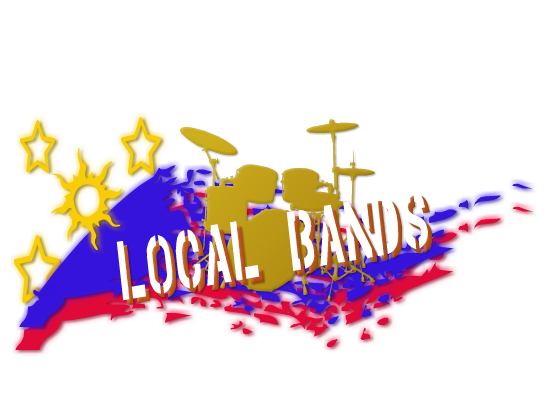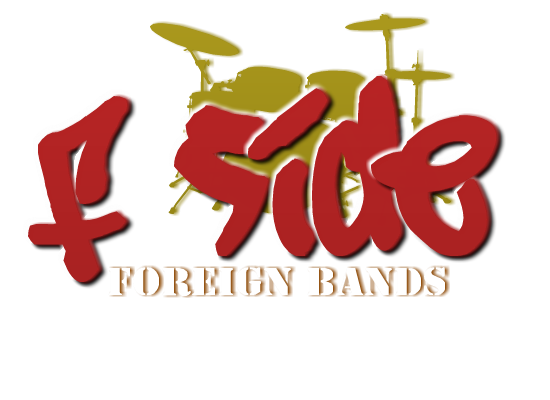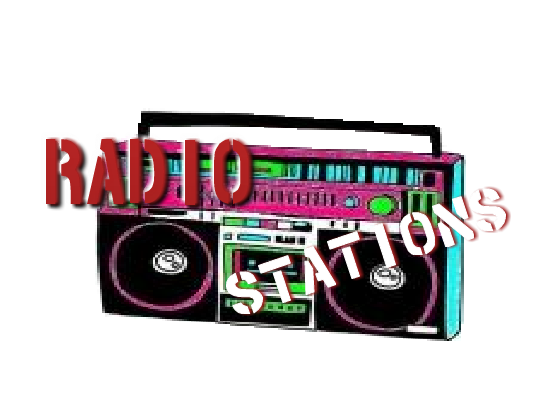Contents[hide] |
[edit] History
One of the first popular Filipino rock stars was Bobby Gonzales, whose major hit was "Hahabul-Habol." Eddie Mesa, another teen idol from the period, became known as the "Elvis Presley of the Philippines." Back then, many Filipinos referred to Rock bands as "combos," many of which used nontraditional instruments like floor-bass bongos, maracas, and gas tanks.[edit] 1960s
In the early 1960s, as electric instruments and new technology became available, instrumental American and British bands like The Shadows and The Ventures flourished. Bands that arose in this period were The Deltas, The Celtics, RJ & the Riots, The Technicolors, The Downbeats, The Hi-Jacks, and The Electromaniacs. These bands spawned the first Filipino singer-songwriters.In 1963, the so-called British Invasion brought bands like The Beatles to mainstream audiences worldwide. Their widespread popularity and their embrace of the counterculture injected the possibility of socio-political lyrics with mature comments on real life into popular music. Immensely influenced by this new breed of British artists, many Filipino bands began adopting similar musical styles.
[edit] 1970s
Into the early 1970s, Filipino music was growing more nationalistic and socio-political in nature, as well as using Tagalog more often. Pop music still dominates the airwaves with disco and funk bands such as the Apo Hiking Society and Hotdog. Songs like Hotdog's "Ikaw ang Miss Universe ng Buhay Ko" (You Are The Miss Universe of My Life) combined Filipino and English within the same song. This helped innovate the so-called "Manila Sound". OPM (Original Pilipino Music) also became popular.However, emerging social and political consciousness somehow creeped in to the industry with the traditional allied genres that are folk and rock music. Folk musicians and bands included Freddie Aguilar, Asin, Florante. (In 1978, Freddie Aguilar's debut single, "Anak", became the most commercially successful Filipino recording in history. The song became known also in other Asian countries and in Europe). Perhaps Asin, an ethnic-folk band, was the first commercial band to successfully bring a pro-environment song to the airwaves with "Masdan Mo Ang Kapaligiran". Also famous for providing subtle rebellious (anti-Marcos dictatorship sentiment was growing at that time) and peace messages behind its skillful vocal harmonizing, Asin gave the masses hits such as "Bayan Kong Sinilangan (Cotabato)" and "Balita".
Juan de la Cruz Band, a garage and blues-rock influenced group consisting of drummer Joey "Pepe" Smith, bassist Mike Hanopol, and lead guitarist Wally Gonzales, are often credited for ushering in the first "rock & roll revolution" in the Philippines that lasted from the late '60s to the late '70s (also known as the Golden Age of Pinoy Rock). Considered by many[who?] to be the "grandfathers" of Pinoy Rock, they played a large role in re-awakening national pride through their bluesy Tagalog rock songs at a time of English-dominant music in the local scene. During a Woodstock-esque concert in Luneta Park, the group performed their original "Himig Natin" for the first time.
Being influenced by the counterculture, the bands of the '70s were known to have never been sidelined commercially and sometimes took the center stage by storm. The radio station DZRJ, particularly the AM weekend "Pinoy Rock and Rhythm" show hosted by the ex-Fine Arts student from Philippine Women's University named Dante David, a.k.a. Howlin' Dave, provided the much-needed support and publicity to Pinoy Rock during this era.
Today, many music journalists[who?] refer to the works of these pioneering artists as Classic Pinoy Rock, perhaps to distinguish them from the works of relatively younger Pinoy Rock bands, especially those that emerged in the 1980s through the 1990s.
[edit] 1980s
In the early up to mid-1980s, Pinoy Rock became the music of Filipino protesters. Gary Granada and the band Buklod had socially relevant lyrics for their songs. Aguilar's Bayan Ko (My Country) became an anthem during the 1986 EDSA Revolution. A subculture rejected this kind of socially-aware lyrics.The most popular Pinoy Rock band in the Philippines in the '80s was arguably The Dawn, whose early songs were largely influenced by New Wave and Post-punk, the dominant Alternative Music genres in the Philippines during that period. The Dawn came to prominence in 1986, when its independently-released single "Enveloped Ideas" became an instant favorite among listeners of DWXB-FM 102.7, a now-defunct FM radio station popular in the mid-'80s that heavily played New Wave, Post-Punk, and similar genres.
Many music journalists and enthusiasts, as well as musicians themselves, attribute the flourishing in the mid-'80s of New Wave- and Post-Punk-influenced bands to DWXB-FM, which began playing independently-released singles of unsigned local bands. This helped many of the struggling bands in this era to achieve cult status. These bands included Dean's December, Ethnic Faces, Identity Crisis, and Violent Playground, all of which were able to record and release their respective albums in the years that followed.
Other Pinoy Rock groups took their cue from these pioneers and started recording their own songs; and this proved beneficial to the Pinoy Rock scene, which brought back creativity and originality to the awareness of fledgling musicians. Among the lot, The Dawn, Afterimage, and Introvoys proved to be the enduring and more successful groups. Each was able to sustain a relatively long career.
DWXB-FM went off the air on June 9, 1987. The new Cory Aquino-led government began sequestering properties owned by her predecessor Ferdinand Marcos and his cronies, including the home that DWXB-FM beamed from. DWXB-FM was revived as an online radio station on September 10, 2005, by Sutton Records, with the original DJs broadcasting from Manila.
[edit] 1990s
During the start of the decade, The Hayp, Introvoys and After Image were among the prominent bands enjoying mainstream recognition. But their collective popularity was later overshadowed by younger bands that eventually emerged. An underground music scene was already burgeoning in some unknown bars in Manila. Red Rocks (which later became Club Dredd), together with Mayric's and Kampo (Yosh in the mid '90s), were the only venues where unsigned bands were allowed to play their own songs. From Power Pop, shoegazer, alternative rock (Eraserheads, Color It Red, The Youth, Feet Like Fins, Advent Call, Athena's Curse, etc.) to hard rock, heavy metal (Razorback, Askals, Wolfgang, Dahong Palay, etc.) to hardcore, punk, and death metal (Skychurch, Genital Grinder, Death After Birth, Kabaong ni Kamatayan, , Loads of Motherhood, The Wuds, Yano, Bad Omen, Rumblebelly, Deifago).To add to the plight of the underground bands, radio stations would not play their music due to the payola system in the radio industry despite the fact that most of these bands, if not all, had self-produced ([[independent music|indie) albums. But DWLA 105.9 challenged the current system by providing a venue for the bands to broadcast their original songs. Pinoy Rock enthuthiasts were finally elated to hear their favorite underground bands ruling the airwaves.
Radio station LA 105.9 advocated Filipino rock music, playing original amateur (even if poorly recorded) singles and gave new avenues for emerging bands outside organized underground concerts. Rock n' Rhythm, a local music magazine also supported this scene with news and updates, band interviews, album and concert reviews, carrying on the torch that the defunct Jingle Chordbook and Moptop (popular Philippine rock music magazines during the '70s and '80s, respectively) have entrailed. The band explosion opened avenues for non-traditional artists as well, like Intermidya, for example. Their musical instruments looked like materials from a junk shop glued together and which had names like Sandata#1, Sandata#2, Baby Sandata, etc.
The commercial success of Eraserheads paved the way for more Pinoy Rock acts (Rivermaya, Rizal Underground, The Youth) getting record deals. Some brave all-female bands got signed (Kelt's Cross, Tribal Fish, Agaw Agimat) and a few solo artists as well (Maegan Aguilar, Bayang Barrios, DJ Alvaro). Rappers crossed over with great success (Francis M with Hardware Syndrome and Erectus), despite some earlier controversy with hiphop-bashing allegedly incited by some artists. These bands adopted a variety of influences both in image and music; many fell under a particular genre; however, the crossing over of styles was most often inevitable.
Unfortunately, around 1994 the height of the Pinoy band scene was exploited up to its wits. Bands were guesting almost everywhere from noon-time TV shows and movies to drama sitcoms like Maalaala Mo Kaya. Even the Miss Universe pageant held in the country was not spared.
Although the '90s were more inclined to be about pop rock bands mentioned above, many Filipino rock fans were ardent supporters of the more creative and independent Filipino underground community. Diverse not by name alone, these underground musicians were not easily attracted to mainstream pop sensibilities and grew their own market without the support of corrupt major labels that some critics and artists viewed as responsible for damaging most Filipino music careers.
A big chunk of these bands shared the same ideology of refusing to be exploited. It was only a matter of time when two factors, piracy and technology, brought major labels to reconsider their business dealings. In effect, most underground musicians secured their own spots in the Metal, Gothic rock, Punk and hardcore genres.
[edit] 2000s
In the early 2000s, Hip hop-, reggae-, acoustic pop/jazz-, and R&B-influenced bands dominated the Philippine music scene, causing Pinoy Rock to take a backseat. Only a number of Pinoy Rock bands managed to stay in the mainstream during this period. In 2003 a not-so-well-known home-educated DJ named DJ RO started playing in a small bar and restaurant known as GWEILOS; DJ RO helped promote the club every Monday night while there was an emergence of Filipino Rock bands like Bamboo, Orange and Lemons and Kitchie Nadal that started performing in Gweilos and eventually became popular. In 2004, Pinoy Rock once again gained prominence, with the rise of yet another wave of Filipino Rock bands. During this time, the Pinoy Rock music scene in Cebu also gained exposure.2001 saw indie band The Pin-Up Girls, made up of former Keltscross members and underground musicians, signing to Know-It-All Records in Tacoma, Washington, making them the first Manila-based band to sign with an American label. This development caused quite a negative reaction from the Manila rock scene as most musicians deemed the band unworthy of the break.
The Pin-Up Girls released an EP worldwide called "Taste Test" that sold out. Know-It-All then printed a new batch dubbed "Taste Test: The Expanded Menu". The lead-off single "Caress" hit number one on the New Jersey- and Internet-based radio www.flashbackalternatives.com.
2004 also saw the emergence of the first Philippine virtual band, Mistula. With the internet as their stage, Mistula comes alive through their official website, a fusion of music, graphic art, literature, photography and other art forms.
The rest of the 2000s further ushered in the mainstream buzz on Pinoy Rock, and along with it bands that leaned more towards pop sensibilities. During this time, Pinoy Rock, more than ever, gained mainstream exposure. Pogi ("pretty-face") rock was born (with such bands as Hale, Sponge Cola, Callalily and the new, post-Rico Blanco Rivermaya), although an obscure, provincial band that called itself Groupies' Panciteria tried to assert a different political path, releasing in 2009 an mp3 album for free downloading on Soundclick.com after having been inspired by the politics of ultra-independent rock artist Dong Abay; the half-send-up-of- and half-tribute-to-commercial-TV 2005 album by the band Itchyworms called Noontime Show; and the downloadable protest-folk albums of Gary Granada.[1][2]
In recent years as well, bands like Urbandub, Chicosci, Slapshock, Pencil Toe and Typecast have also played in other countries such as Singapore and the US, amongst others. Some have even garnered nominations and recognition from internationally-based publications and award-giving bodies. This is mainly attributed to the effect of the internet and globalization on almost anything including music, as listeners from other countries can now see and hear songs and videos of bands overseas without leaving their country.
[edit] See also
[edit] References
- ^ Groupies' Panciteria's free-downloadable mp3 album Heto Na . . . Ating Jackal Virgin on Soundclick.com
- ^ certain albums of Gary Granada continue to be offered for free downloading as mp3 files at his website








0 comments:
Post a Comment